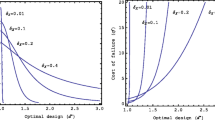Abstract
The current push in industry is focused on ensuring not only that a product performs as desired but also that the product consistently performs as desired. To ensure consistency in product performance, “quality” is measured, improved, and controlled. Most quality initiatives have originated and been implemented in the product manufacturing stages. More recently, however, it has been observed that much of a product’s performance and quality is determined by early design decisions, by the design choices made early in the product design cycle. Consequently, quality pushes have made their way into the design cycle, and “design for quality” is the primary objective. How is this objective measured and met?
The most recent quality philosophy, also originating in a manufacturing setting, is six sigma. The concepts of six sigma quality can be defined in an engineering design context through relation to the concepts of design reliability and robustness – probabilistic design approaches. Within this context, design quality is measured with respect to probability of constraint satisfaction and sensitivity of performance objectives, both of which can be related to a design “sigma level”. In this paper, we define six sigma in an engineering design context and present an implementation of design for six sigma – a robust optimization formulation that incorporates approaches from structural reliability and robust design with the concepts and philosophy of six sigma. This formulation is demonstrated using a complex automotive application: vehicle side impact crash simulation. Results presented illustrate the tradeoff between performance and quality when optimizing for six sigma reliability and robustness.
Similar content being viewed by others
References
Athan, T.W.; Papalambros, P.Y. 1996: A Note on Weighted Criteria Methods for Compromise Solutions in Multi-Objective Optimization. Engineering Optimization 27(2), 155–176
Belegundu, A.D. 1988: Probabilistic Optimal Design Using Second Moment Criteria. Journal of Mechanisms, Transmissions, and Automation in Design 110(3), 324–329
Byrne, D.M.; Taguchi, S. 1987: The Taguchi Approach to Parameter Design. 40th Annual Quality Congress Transactions. Milwaukee, Wisconsin: American Society for Quality Control, 19–26
Chen, W.; Allen, J.K.; Tsui, K.-L.; Mistree, F. 1996: A Procedure for Robust Design: Minimizing Variations Caused by Noise Factors and Control Factors. ASME Journal of Mechanical Design 118(4), 478–485
Chen, X.; Hasselman, T.K.; Neill, D.J. 1997: Reliability Based Structural Design Optimization for Practical Applications. 38th AIAA/ASME/ ASCE/AHS/ASC, Structures, Structural Dynamics and Materials Conference, 2724–2732. Kissimmee, FL. Paper No. AIAA-97-1403
Choi, K.K.; Yu, X.; Chang, K. 1996: A Mixed Design Approach for Probabilistic Structural Durability. 6th AIAA/USAF/NASA/ ISSMO Symposium on Multidisciplinary Analysis and Optimization, Bellevue, WA., 785–795
Cornell, C.A. 1969: A Probability-Based Structural Code. Journal of American Concrete Institute 66(12), 974–985
Hahn, G.J.; Shapiro, S.S. 1994: Statistical Models in Engineering. Wiley-Interscience, New York: John Wiley & Sons
Hammersley, J.M.; Handscomb, D.C. 1964: Monte Carlo Methods. London: Chapman and Hall
Harry, M.J. 1997: The Nature of Six Sigma Quality. Shaumburg, Illinois: Motorola University Press.
Harry, M.; Schroeder, R. 2000: Six Sigma: The Breakthrough Management Strategy Revolutionizing the World’s Top Corporations. New York: Doubleday
Hasofer, A.M.; Lind, N.C. 1974: Exact and Invariant Second Moment Code Format. Journal of Engineering Mechanics, ASCE 100, No. EM1, 111–121
Hohenbichler, M.; Rackwitz, R. 1981: Non-normal Dependent Vectors in Structural Safety. Journal of Engineering Mechanics, ASCE 107, NO. EM6, 1227–1237
Hsieh, C.-C.; Oh, K.P. 1992: MARS: A computer-based method for achieving robust systems, FISITA Conference. The Integration of Design and Manufacture 1, 115–120
Koch, P.N.; Evans, J.P.; Powell, D. 2002: Interdigitation for Effective Design Space Exploration using iSIGHT. Journal of Structural and Multidisciplinary Optimization 23(2), 111–126
Koch, P.N.; Kodiyalam, S. 1999: Variable Complexity Structural Reliability Analysis for Efficient Reliability-Based Design Optimization. 40th AIAA/ASME/ASCE/AHS/ASC Structures, Structural Dynamics, and Materials Conference, St. Louis, Missouri, 68–77. AIAA-99-1210
Koch, P.N.; Wujek, B.; Golovidov, O. 2000: A Multi-Stage, Parallel Implementation of Probabilistic Design Optimization in an MDO Framework. 8th AIAA/USAF/NASA/ISSMO Symposium on Multidisciplinary Analysis and Optimization, Long Beach, CA., AIAA-2000-4805
Madsen, H.O.; Krenk, S.; Lind, N.C. 1986: Methods of Structural Safety. New Jersey: Prentice-Hall, Englewood Cliffs
Melchers, R.E. 1999: Structural Reliability: Analysis and Prediction, 2nd edn. Ellis Horwood Series in Civil Engineering. New York: John Wiley & Sons
Montgomery, D.C. 1996: Design and Analysis of Experiments. New York: John Wiley & Sons
Pande, P.S.; Neuman, R.P.; Cavanagh, R.R. 2000: The Six Sigma Way: How GE, Motorola, and Other Top Companies are Honing Their Performance. New York: McGraw-Hill
Phadke, M.S. 1989: Quality Engineering using Robust Design. New Jersey: Prentice Hall, Englewood Cliffs
Rackwitz, R.; Fiessler, B. 1978: Structural Stability Under combined Random Load Sequences. Computers and Structures 9, 489–494
Ross, P.J. 1996: Taguchi Techniques for Quality Engineering. 2nd edn., New York: McGraw-Hill
Saliby, E. 1990: Descriptive Sampling: A Better Approach to Monte Carlo Simulation. J. Opl. Res. Soc. 41(12), 1133–1142
Simpson, T.W.; Allen, J.K.; Mistree, F. 1998: Spatial Correlation Metamodels for Global Approximation in Structural Design Optimization. ASME Design Engineering Technical Conferences, Atlanta, GA, ASME DETC98/DAC-5613
Simpson, T.W.; Mauery, T.M.; Korte, J.J.; Mistree, F. 2001: Kriging Models for Global Approximation in Simulation-Based Multidisciplinary Design Optimization. AIAA Journal 39(12), 2233–2241
Thanedar, P.B.; Kodiyalam, S. 1991: Structural Optimization using Probabilistic Constraints, AIAA/ASME/ACE/AHS/ASC Structures. Structural Dynamics and Materials Conference, 205–212, AIAA-91-0922-CP
Thoft-Christensen, P.; Baker, M.J. 1982: Structural Reliability Theory and Its Applications. Berlin: Springer-Verlag
Xiao, Q.; Sues, R.H.; Rhodes, G.S. 1999: Multi-Disciplinary Wing Shape Optimization with Uncertain Parameters. 40th AIAA/ASME/ASCE/ AHS/ASC Structures, Structural Dynamics, and Materials Conference, St. Louis, Missouri, 3005–3014 . Paper No. AIAA-99-1601
Ziha, K. 1995: Descriptive sampling in structural safety. Structural Safety 17, 33–41
Author information
Authors and Affiliations
Corresponding author
Rights and permissions
About this article
Cite this article
Koch , P., Yang , RJ. & Gu , L. Design for six sigma through robust optimization. Struct Multidisc Optim 26, 235–248 (2004). https://doi.org/10.1007/s00158-003-0337-0
Received:
Revised:
Published:
Issue Date:
DOI: https://doi.org/10.1007/s00158-003-0337-0




